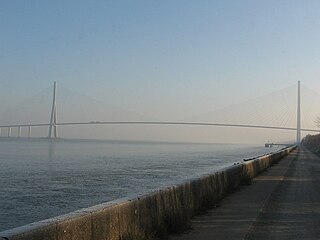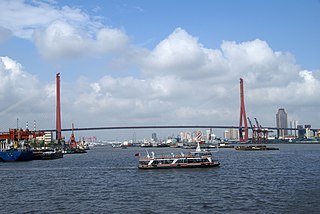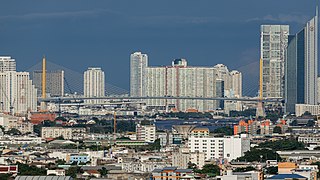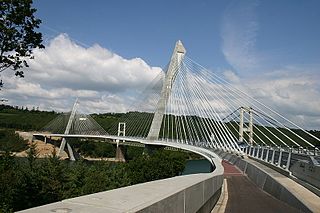
A suspension bridge is a type of bridge in which the deck is hung below suspension cables on vertical suspenders. The first modern examples of this type of bridge were built in the early 1800s. Simple suspension bridges, which lack vertical suspenders, have a long history in many mountainous parts of the world.

A cable-stayed bridge has one or more towers, from which cables support the bridge deck. A distinctive feature are the cables or stays, which run directly from the tower to the deck, normally forming a fan-like pattern or a series of parallel lines. This is in contrast to the modern suspension bridge, where the cables supporting the deck are suspended vertically from the main cable, anchored at both ends of the bridge and running between the towers. The cable-stayed bridge is optimal for spans longer than cantilever bridges and shorter than suspension bridges. This is the range within which cantilever bridges would rapidly grow heavier, and suspension bridge cabling would be more costly.

The Hungerford Bridge crosses the River Thames in London, and lies between Waterloo Bridge and Westminster Bridge. Owned by Network Rail Infrastructure Ltd it is a steel truss railway bridge flanked by two more recent, cable-stayed, pedestrian bridges that share the railway bridge's foundation piers, and which are named the Golden Jubilee Bridges.

The Millau Viaduct is a multispan cable-stayed bridge completed in 2004 across the gorge valley of the Tarn near Millau in the Aveyron department in the Occitanie Region, in Southern France. The design team was led by engineer Michel Virlogeux and English architect Norman Foster. As of September 2020, it is the tallest bridge in the world, having a structural height of 336.4 metres (1,104 ft).

The Rio–Antirrio Bridge, officially the Charilaos Trikoupis Bridge, is one of the world's longest multi-span cable-stayed bridges and longest of the fully suspended type. It crosses the Gulf of Corinth near Patras, linking the town of Rio on the Peloponnese peninsula to Antirrio on mainland Greece by road. It opened one day before the Athens 2004 Summer Olympics, on 12 August 2004, and was used to transport the Olympic flame.

The Pont de Normandie is a cable-stayed road bridge that spans the river Seine linking Le Havre to Honfleur in Normandy, northern France. Its total length is 2,143.21 metres (7,032 ft) – 856 metres (2,808 ft) between the two piers. It is also the last bridge to cross the Seine before it empties into the ocean. It is a motorway toll bridge, but there is also a footpath and a narrow cycle lane in each direction allowing pedestrians and cyclists to cross the bridge free of charge.

Bangabandhu Bridge, commonly called the Jamuna Multi-purpose Bridge is a bridge opened in Bangladesh in June 1998. It connects Bhuapur on the Jamuna River's east bank to Sirajganj on its west bank. It was the 11th longest bridge in the world when constructed in 1998 and at present is the 6th longest bridge in South Asia. The Jamuna River, which it spans, is one of the three major rivers of Bangladesh, and is fifth largest in the world in discharge volume.

The Waldo–Hancock Bridge was the first long-span suspension bridge erected in Maine, as well as the first permanent bridge across the Penobscot River below Bangor. The name comes from connecting Waldo and Hancock counties. The bridge was built in 1931 and retired in 2006, when the new Penobscot Narrows Bridge was opened just a few yards away, and it was demolished in 2013.

An extradosed bridge employs a structure that combines the main elements of both a prestressed box girder bridge and a cable-stayed bridge. The name comes from the word extrados, the exterior or upper curve of an arch, and refers to how the "stay cables" on an extradosed bridge are not considered as such in the design, but are instead treated as external prestressing tendons deviating upward from the deck. In this concept, they remain part of the main bridge superstructure.

The Yangpu Bridge is a sister bridge to the Nanpu Bridge, both crossing the Huangpu River in Shanghai, China. Yangpu is among the world's longest bridges, with a total length of 8354 meters. Its longest span of 602 m makes it one of the longest cable-stayed bridges in the world. It carries the Inner Ring Road from the Yangpu District in Puxi to the Pudong New Area. It was completed in September 1993 and opened in October. It is the last vehicular bridge over the Huangpu River before the river empties into the sea.

Rama IX Bridge is a bridge in Bangkok, Thailand over the Chao Phraya River. It connects the Yan Nawa District to Rat Burana District as a part of the Dao Khanong – Port Section of Chalerm Maha Nakhon Expressway.

This is the timeline of the 3 longest supported deck arch bridge spans in the world, where the road deck lies on top of the arch. The deck is supported by columns, truss, rubble or lies directly on the arch. These bridges are often found in narrow valleys.

The Russky Bridge is a cable-stayed bridge in Vladivostok, Primorsky Krai, Russia. The bridge connects the Russky Island and the Muravyov-Amursky Peninsula sections of the city across the Eastern Bosphorus strait, and with a central span of 1,104 metres it is the longest cable-stayed bridge in the world. The Russky Bridge was originally built to serve the 2012 Asia-Pacific Economic Cooperation conference hosted at the Far Eastern Federal University campus on Russky Island. It was completed in July 2012 and opened by Prime Minister Dmitry Medvedev, and on September 3, 2012, the bridge was officially given its name.

Vidyasagar Setu, also known as the Second Hooghly Bridge, is a toll bridge over the Hooghly River in West Bengal, India, linking the cities of Kolkata and Howrah.

The Térénez bridge is a cable-stayed bridge, located between Landévennec and Rosnoën, Finistère, France.

The Taizhou Yangtze River Bridge is a bridge complex over the Lower Yangtze River in Jiangsu Province in eastern China. The bridge connects Taizhou on the north bank, Yangzhong on an island in the river, and Yaoqiao Village of Zhenjiang Municipality on the south bank, and consists of a suspension bridge across the north branch stream and a pair of box-girder bridges across the south branch stream. Taizhou Bridge Complex opened in 2012.
In forestry, a tree crown measurement is one of the tree measurements taken at the crown of a tree, which consists of the mass of foliage and branches growing outward from the trunk of the tree. The average crown spread is the average horizontal width of the crown, taken from dripline to dripline as one moves around the crown. The dripline being the outer boundary to the area located directly under the outer circumference of the tree branches. When the tree canopy gets wet, any excess water is shed to the ground along this dripline. Some listings will also list the maximum crown spread which represents the greatest width from dripline to dripline across the crown. Other crown measurements that are commonly taken include limb length, crown volume, and foliage density. Canopy mapping surveys the position and size of all of the limbs down to a certain size in the crown of the tree and is commonly used when measuring the overall wood volume of a tree.

The Jiaxing-Shaoxing Sea Bridge, sometimes shortened to Jiashao Bridge, is the world's longest and widest multi-pylon cable-stayed bridge. From end to end, it stretches 10.14 km (6.3 mi) across the Qiantang River estuary, at Shaoxing, Zhejiang, China. The main bridge is 2,680 m (8,790 ft) long and 55.6 m (182 ft) wide and carries an expressway with eight traffic lanes. Construction started December 2008, and the toll bridge opened for traffic on July 20, 2013.


















